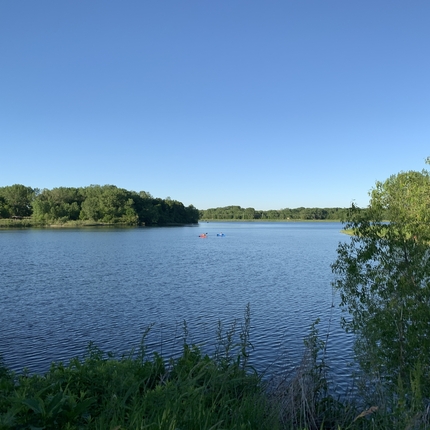By Cody Smith, former staff member
Flowing Forward is a multi-part series that investigates Iowa’s water quality issues. The series includes three fact sheets that analyze the historical context and current administrative framework, as well as provide a road map for addressing this complex challenge. The fact sheets are based on the recently released report, “Flowing Forward: Planning Iowa’s Water Quality Future,” written by Katie Rock.
The state of Iowa has a lot of water. In fact, the state contains more than two dozen rivers, including the Missouri and Mississippi Rivers. For many years, state leaders have grappled with the question of how to improve the quality of Iowa’s waterways. Meanwhile, lakes have been listed as “impaired” by the Iowa Department of Natural Resources and rivers have elevated levels of nutrients, like nitrogen and phosphorus, flowing downstream. But, the impacts of poor water quality in the state have expansive consequences which have caused issues as far south as the Gulf of Mexico.
At a base level, the problem is a result of two types of water pollution—point source and nonpoint source pollution. Point source pollution refers to entities that discharge pollutants directly into Iowa’s water through a specific point of discharge. This often includes water treatment plants and factories and are heavily regulated. Nonpoint source pollution includes sources where contaminants find their way to the body of water through natural drainage. Farm runoff is a form of nonpoint source pollution, and is largely unregulated.
Both types of pollution have contributed to what is known as the “Dead Zone” at the estuary of the Mississippi River and the Gulf of Mexico. This area, now the size of New Jersey, is referred to as the Dead Zone because of its inability to sustain aquatic life. Excess nutrients enter the water from both nonpoint and point source polluters in the 12 states in the Mississippi River Watershed. Once those nutrients reach the water, they allow for a boom of algae growth, which later dies. Upon death, the algae sucks up most of the available oxygen in the water, making it impossible for aquatic life to thrive. This is referred to as eutrophication resulting in hypoxia.
In fall 1997, the U.S. Environmental Protection Agency (EPA) convened a Mississippi River/Gulf of Mexico Watershed Nutrient Task Force to address this issue. The group became commonly known as the Hypoxia Task Force and included the 12 states within the Mississippi River Watershed—Arkansas, Illinois, Indiana, Iowa, Kentucky, Louisiana, Minnesota, Mississippi, Missouri, Ohio, Tennessee, and Wisconsin. The task force released a 2001 action plan which eventually led to a 2008 call for each member state to create a strategy to reduce their water quality impact on the Dead Zone. In 2011, the EPA outlined what elements should be included in a state nutrient reduction strategy in a memo to states in the Mississippi River watershed.
From this call to action, the Iowa Nutrient Reduction Strategy was born. The strategy was a partnership between Iowa State University, the Iowa Department of Agriculture and Land Stewardship, and the Iowa Department of Natural Resources. The Nutrient Reduction Strategy calls for a statewide goal of reducing nitrogen and phosphorus in Iowa’s waterways by 45 percent by 2035. While progress has been made, the strategy still faces some major challenges.
At the current rate of progress, the goal will be achieved long after the target date of 2035. And, while the strategy sets important goals and provides a framework for progress, it is voluntary and does not identify funding for itself. While Iowa has invested approximately $541 million in water quality projects over many years, experts say the total cost to achieve this goal range from $4.8 billion to $9.6 billion.
As Iowa continues to carve its own path forward to improve water quality, looking to other Hypoxia Task Force states may offer guidance for different approaches for scaling up project implementation. Efforts in other states have included an emphasis on watershed planning, which acts as a road map for progress. To view more about Iowa’s role in cleaning up the Gulf, check out our fact sheet here.





